Assessment and Management of a Patient with Fracture and High Blood Pressure
VerifiedAdded on 2023/06/15
|6
|1918
|483
AI Summary
Miss Jane Green, a 30-year-old female, was hit by a car resulting in an obvious left lower leg fracture. She has high blood pressure and increased heart rate due to acute pain. The patient is anxious about her mother's welfare. The priority of care is to address the patient's pain and reduce her anxiety level. The patient outcome is evaluated by reduced perceived pain, improved well-being, and reduced anxiety related to her mother.
Contribute Materials
Your contribution can guide someone’s learning journey. Share your
documents today.
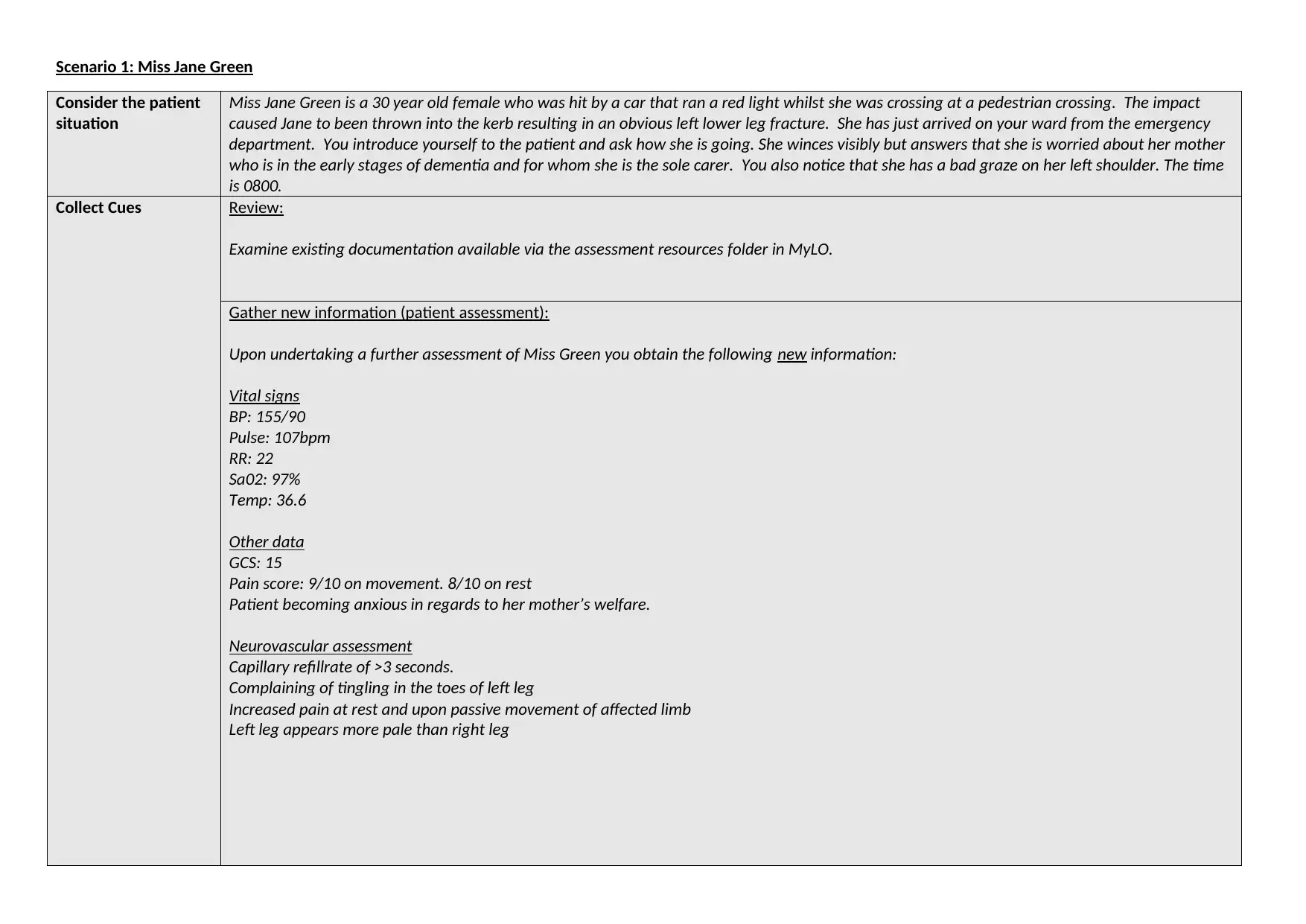
Scenario 1: Miss Jane Green
Consider the patient
situation
Miss Jane Green is a 30 year old female who was hit by a car that ran a red light whilst she was crossing at a pedestrian crossing. The impact
caused Jane to been thrown into the kerb resulting in an obvious left lower leg fracture. She has just arrived on your ward from the emergency
department. You introduce yourself to the patient and ask how she is going. She winces visibly but answers that she is worried about her mother
who is in the early stages of dementia and for whom she is the sole carer. You also notice that she has a bad graze on her left shoulder. The time
is 0800.
Collect Cues Review:
Examine existing documentation available via the assessment resources folder in MyLO.
Gather new information (patient assessment):
Upon undertaking a further assessment of Miss Green you obtain the following new information:
Vital signs
BP: 155/90
Pulse: 107bpm
RR: 22
Sa02: 97%
Temp: 36.6
Other data
GCS: 15
Pain score: 9/10 on movement. 8/10 on rest
Patient becoming anxious in regards to her mother’s welfare.
Neurovascular assessment
Capillary refillrate of >3 seconds.
Complaining of tingling in the toes of left leg
Increased pain at rest and upon passive movement of affected limb
Left leg appears more pale than right leg
Consider the patient
situation
Miss Jane Green is a 30 year old female who was hit by a car that ran a red light whilst she was crossing at a pedestrian crossing. The impact
caused Jane to been thrown into the kerb resulting in an obvious left lower leg fracture. She has just arrived on your ward from the emergency
department. You introduce yourself to the patient and ask how she is going. She winces visibly but answers that she is worried about her mother
who is in the early stages of dementia and for whom she is the sole carer. You also notice that she has a bad graze on her left shoulder. The time
is 0800.
Collect Cues Review:
Examine existing documentation available via the assessment resources folder in MyLO.
Gather new information (patient assessment):
Upon undertaking a further assessment of Miss Green you obtain the following new information:
Vital signs
BP: 155/90
Pulse: 107bpm
RR: 22
Sa02: 97%
Temp: 36.6
Other data
GCS: 15
Pain score: 9/10 on movement. 8/10 on rest
Patient becoming anxious in regards to her mother’s welfare.
Neurovascular assessment
Capillary refillrate of >3 seconds.
Complaining of tingling in the toes of left leg
Increased pain at rest and upon passive movement of affected limb
Left leg appears more pale than right leg
Secure Best Marks with AI Grader
Need help grading? Try our AI Grader for instant feedback on your assignments.
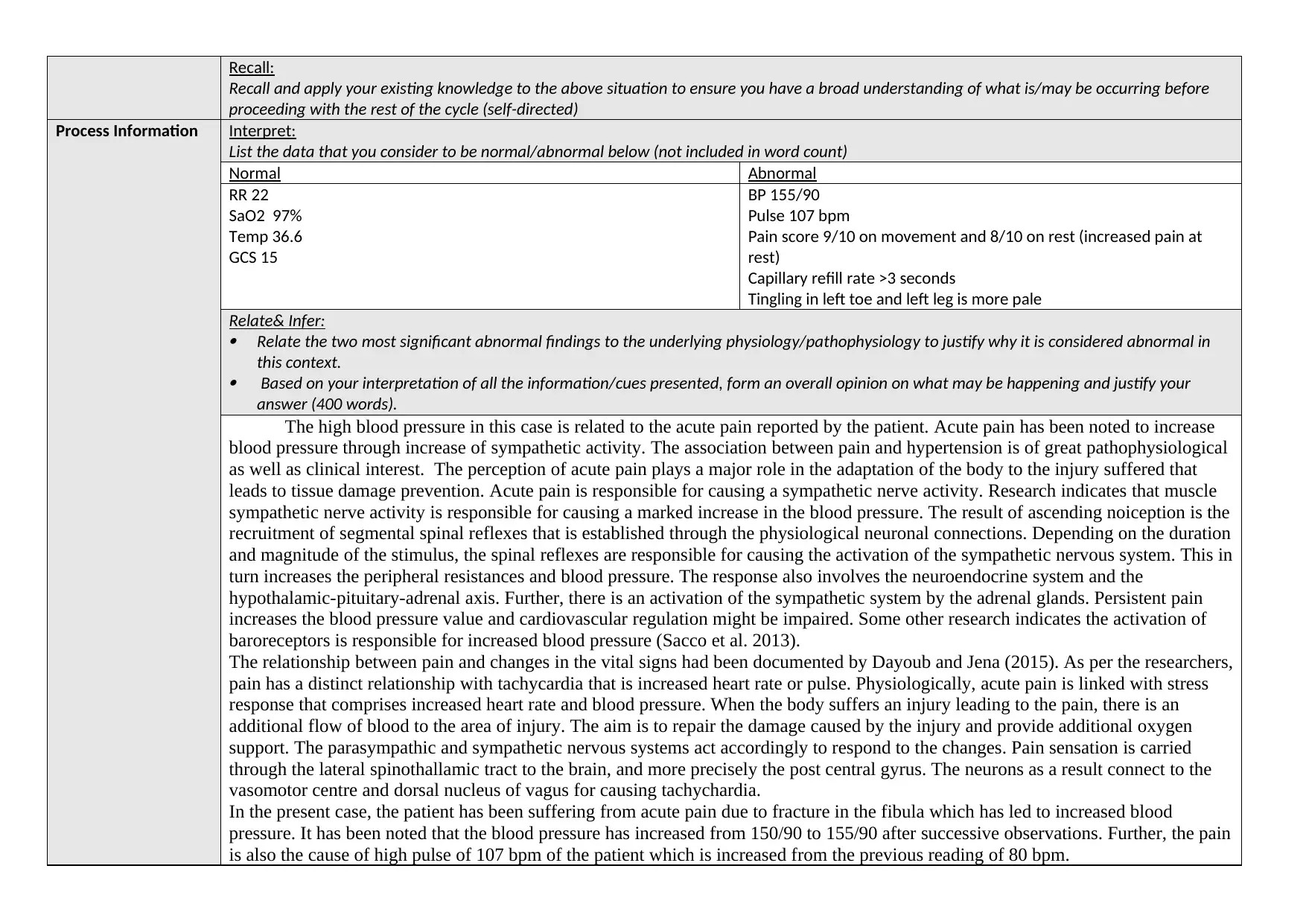
Recall:
Recall and apply your existing knowledge to the above situation to ensure you have a broad understanding of what is/may be occurring before
proceeding with the rest of the cycle (self-directed)
Process Information Interpret:
List the data that you consider to be normal/abnormal below (not included in word count)
Normal Abnormal
RR 22
SaO2 97%
Temp 36.6
GCS 15
BP 155/90
Pulse 107 bpm
Pain score 9/10 on movement and 8/10 on rest (increased pain at
rest)
Capillary refill rate >3 seconds
Tingling in left toe and left leg is more pale
Relate& Infer:
Relate the two most significant abnormal findings to the underlying physiology/pathophysiology to justify why it is considered abnormal in
this context.
Based on your interpretation of all the information/cues presented, form an overall opinion on what may be happening and justify your
answer (400 words).
The high blood pressure in this case is related to the acute pain reported by the patient. Acute pain has been noted to increase
blood pressure through increase of sympathetic activity. The association between pain and hypertension is of great pathophysiological
as well as clinical interest. The perception of acute pain plays a major role in the adaptation of the body to the injury suffered that
leads to tissue damage prevention. Acute pain is responsible for causing a sympathetic nerve activity. Research indicates that muscle
sympathetic nerve activity is responsible for causing a marked increase in the blood pressure. The result of ascending noiception is the
recruitment of segmental spinal reflexes that is established through the physiological neuronal connections. Depending on the duration
and magnitude of the stimulus, the spinal reflexes are responsible for causing the activation of the sympathetic nervous system. This in
turn increases the peripheral resistances and blood pressure. The response also involves the neuroendocrine system and the
hypothalamic-pituitary-adrenal axis. Further, there is an activation of the sympathetic system by the adrenal glands. Persistent pain
increases the blood pressure value and cardiovascular regulation might be impaired. Some other research indicates the activation of
baroreceptors is responsible for increased blood pressure (Sacco et al. 2013).
The relationship between pain and changes in the vital signs had been documented by Dayoub and Jena (2015). As per the researchers,
pain has a distinct relationship with tachycardia that is increased heart rate or pulse. Physiologically, acute pain is linked with stress
response that comprises increased heart rate and blood pressure. When the body suffers an injury leading to the pain, there is an
additional flow of blood to the area of injury. The aim is to repair the damage caused by the injury and provide additional oxygen
support. The parasympathic and sympathetic nervous systems act accordingly to respond to the changes. Pain sensation is carried
through the lateral spinothallamic tract to the brain, and more precisely the post central gyrus. The neurons as a result connect to the
vasomotor centre and dorsal nucleus of vagus for causing tachychardia.
In the present case, the patient has been suffering from acute pain due to fracture in the fibula which has led to increased blood
pressure. It has been noted that the blood pressure has increased from 150/90 to 155/90 after successive observations. Further, the pain
is also the cause of high pulse of 107 bpm of the patient which is increased from the previous reading of 80 bpm.
Recall and apply your existing knowledge to the above situation to ensure you have a broad understanding of what is/may be occurring before
proceeding with the rest of the cycle (self-directed)
Process Information Interpret:
List the data that you consider to be normal/abnormal below (not included in word count)
Normal Abnormal
RR 22
SaO2 97%
Temp 36.6
GCS 15
BP 155/90
Pulse 107 bpm
Pain score 9/10 on movement and 8/10 on rest (increased pain at
rest)
Capillary refill rate >3 seconds
Tingling in left toe and left leg is more pale
Relate& Infer:
Relate the two most significant abnormal findings to the underlying physiology/pathophysiology to justify why it is considered abnormal in
this context.
Based on your interpretation of all the information/cues presented, form an overall opinion on what may be happening and justify your
answer (400 words).
The high blood pressure in this case is related to the acute pain reported by the patient. Acute pain has been noted to increase
blood pressure through increase of sympathetic activity. The association between pain and hypertension is of great pathophysiological
as well as clinical interest. The perception of acute pain plays a major role in the adaptation of the body to the injury suffered that
leads to tissue damage prevention. Acute pain is responsible for causing a sympathetic nerve activity. Research indicates that muscle
sympathetic nerve activity is responsible for causing a marked increase in the blood pressure. The result of ascending noiception is the
recruitment of segmental spinal reflexes that is established through the physiological neuronal connections. Depending on the duration
and magnitude of the stimulus, the spinal reflexes are responsible for causing the activation of the sympathetic nervous system. This in
turn increases the peripheral resistances and blood pressure. The response also involves the neuroendocrine system and the
hypothalamic-pituitary-adrenal axis. Further, there is an activation of the sympathetic system by the adrenal glands. Persistent pain
increases the blood pressure value and cardiovascular regulation might be impaired. Some other research indicates the activation of
baroreceptors is responsible for increased blood pressure (Sacco et al. 2013).
The relationship between pain and changes in the vital signs had been documented by Dayoub and Jena (2015). As per the researchers,
pain has a distinct relationship with tachycardia that is increased heart rate or pulse. Physiologically, acute pain is linked with stress
response that comprises increased heart rate and blood pressure. When the body suffers an injury leading to the pain, there is an
additional flow of blood to the area of injury. The aim is to repair the damage caused by the injury and provide additional oxygen
support. The parasympathic and sympathetic nervous systems act accordingly to respond to the changes. Pain sensation is carried
through the lateral spinothallamic tract to the brain, and more precisely the post central gyrus. The neurons as a result connect to the
vasomotor centre and dorsal nucleus of vagus for causing tachychardia.
In the present case, the patient has been suffering from acute pain due to fracture in the fibula which has led to increased blood
pressure. It has been noted that the blood pressure has increased from 150/90 to 155/90 after successive observations. Further, the pain
is also the cause of high pulse of 107 bpm of the patient which is increased from the previous reading of 80 bpm.
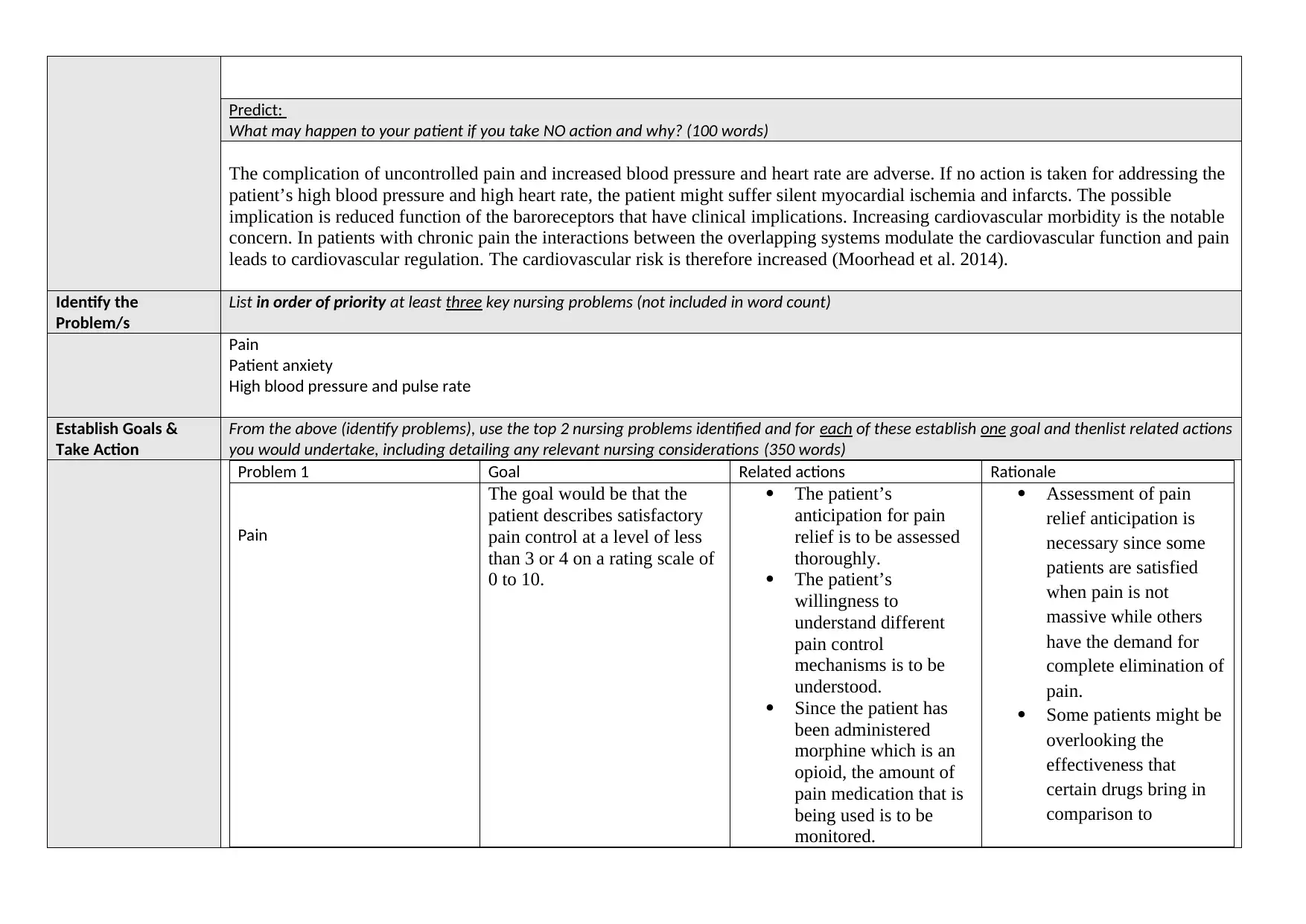
Predict:
What may happen to your patient if you take NO action and why? (100 words)
The complication of uncontrolled pain and increased blood pressure and heart rate are adverse. If no action is taken for addressing the
patient’s high blood pressure and high heart rate, the patient might suffer silent myocardial ischemia and infarcts. The possible
implication is reduced function of the baroreceptors that have clinical implications. Increasing cardiovascular morbidity is the notable
concern. In patients with chronic pain the interactions between the overlapping systems modulate the cardiovascular function and pain
leads to cardiovascular regulation. The cardiovascular risk is therefore increased (Moorhead et al. 2014).
Identify the
Problem/s
List in order of priority at least three key nursing problems (not included in word count)
Pain
Patient anxiety
High blood pressure and pulse rate
Establish Goals &
Take Action
From the above (identify problems), use the top 2 nursing problems identified and for each of these establish one goal and thenlist related actions
you would undertake, including detailing any relevant nursing considerations (350 words)
Problem 1 Goal Related actions Rationale
Pain
The goal would be that the
patient describes satisfactory
pain control at a level of less
than 3 or 4 on a rating scale of
0 to 10.
The patient’s
anticipation for pain
relief is to be assessed
thoroughly.
The patient’s
willingness to
understand different
pain control
mechanisms is to be
understood.
Since the patient has
been administered
morphine which is an
opioid, the amount of
pain medication that is
being used is to be
monitored.
Assessment of pain
relief anticipation is
necessary since some
patients are satisfied
when pain is not
massive while others
have the demand for
complete elimination of
pain.
Some patients might be
overlooking the
effectiveness that
certain drugs bring in
comparison to
What may happen to your patient if you take NO action and why? (100 words)
The complication of uncontrolled pain and increased blood pressure and heart rate are adverse. If no action is taken for addressing the
patient’s high blood pressure and high heart rate, the patient might suffer silent myocardial ischemia and infarcts. The possible
implication is reduced function of the baroreceptors that have clinical implications. Increasing cardiovascular morbidity is the notable
concern. In patients with chronic pain the interactions between the overlapping systems modulate the cardiovascular function and pain
leads to cardiovascular regulation. The cardiovascular risk is therefore increased (Moorhead et al. 2014).
Identify the
Problem/s
List in order of priority at least three key nursing problems (not included in word count)
Pain
Patient anxiety
High blood pressure and pulse rate
Establish Goals &
Take Action
From the above (identify problems), use the top 2 nursing problems identified and for each of these establish one goal and thenlist related actions
you would undertake, including detailing any relevant nursing considerations (350 words)
Problem 1 Goal Related actions Rationale
Pain
The goal would be that the
patient describes satisfactory
pain control at a level of less
than 3 or 4 on a rating scale of
0 to 10.
The patient’s
anticipation for pain
relief is to be assessed
thoroughly.
The patient’s
willingness to
understand different
pain control
mechanisms is to be
understood.
Since the patient has
been administered
morphine which is an
opioid, the amount of
pain medication that is
being used is to be
monitored.
Assessment of pain
relief anticipation is
necessary since some
patients are satisfied
when pain is not
massive while others
have the demand for
complete elimination of
pain.
Some patients might be
overlooking the
effectiveness that
certain drugs bring in
comparison to
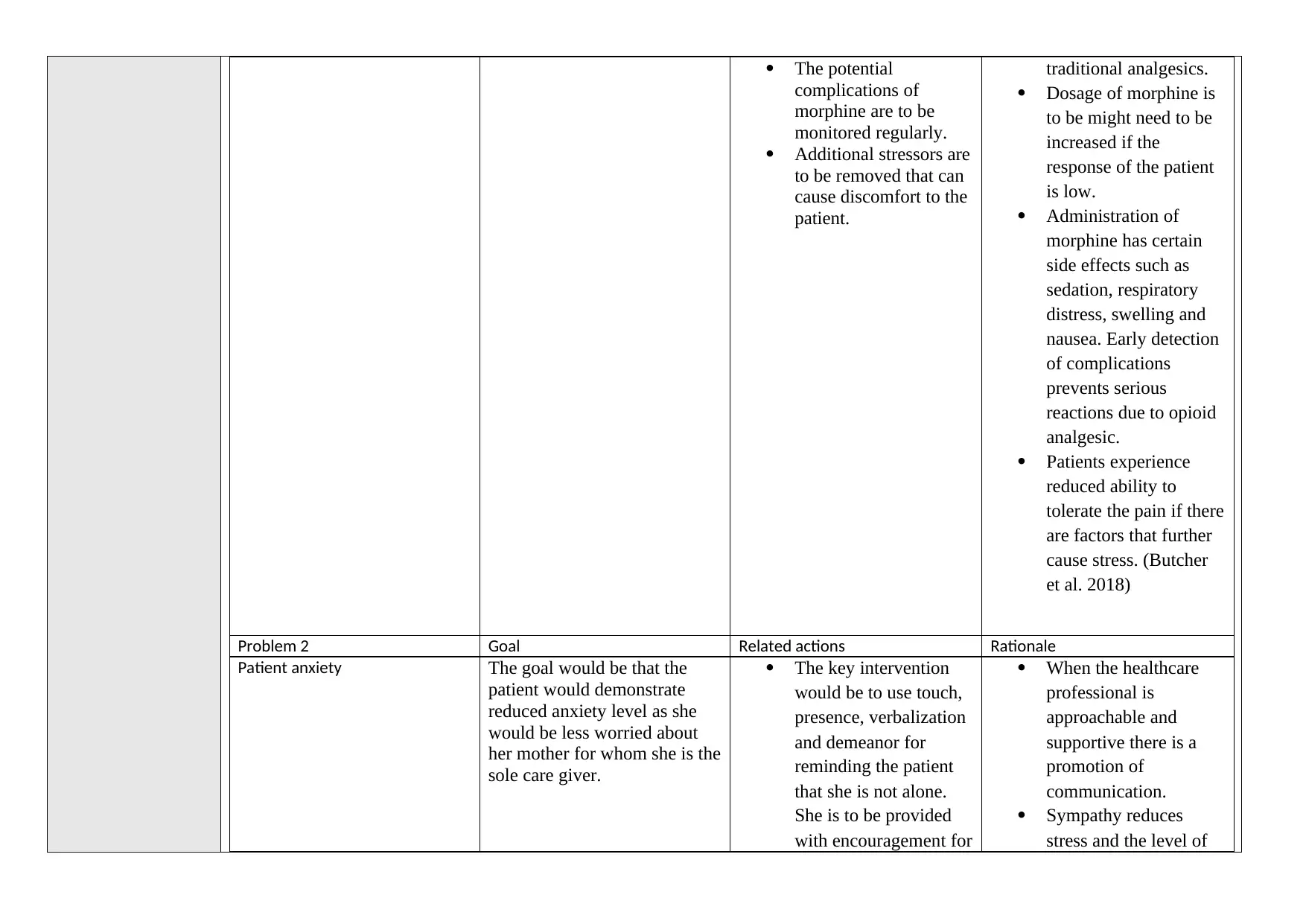
The potential
complications of
morphine are to be
monitored regularly.
Additional stressors are
to be removed that can
cause discomfort to the
patient.
traditional analgesics.
Dosage of morphine is
to be might need to be
increased if the
response of the patient
is low.
Administration of
morphine has certain
side effects such as
sedation, respiratory
distress, swelling and
nausea. Early detection
of complications
prevents serious
reactions due to opioid
analgesic.
Patients experience
reduced ability to
tolerate the pain if there
are factors that further
cause stress. (Butcher
et al. 2018)
Problem 2 Goal Related actions Rationale
Patient anxiety The goal would be that the
patient would demonstrate
reduced anxiety level as she
would be less worried about
her mother for whom she is the
sole care giver.
The key intervention
would be to use touch,
presence, verbalization
and demeanor for
reminding the patient
that she is not alone.
She is to be provided
with encouragement for
When the healthcare
professional is
approachable and
supportive there is a
promotion of
communication.
Sympathy reduces
stress and the level of
complications of
morphine are to be
monitored regularly.
Additional stressors are
to be removed that can
cause discomfort to the
patient.
traditional analgesics.
Dosage of morphine is
to be might need to be
increased if the
response of the patient
is low.
Administration of
morphine has certain
side effects such as
sedation, respiratory
distress, swelling and
nausea. Early detection
of complications
prevents serious
reactions due to opioid
analgesic.
Patients experience
reduced ability to
tolerate the pain if there
are factors that further
cause stress. (Butcher
et al. 2018)
Problem 2 Goal Related actions Rationale
Patient anxiety The goal would be that the
patient would demonstrate
reduced anxiety level as she
would be less worried about
her mother for whom she is the
sole care giver.
The key intervention
would be to use touch,
presence, verbalization
and demeanor for
reminding the patient
that she is not alone.
She is to be provided
with encouragement for
When the healthcare
professional is
approachable and
supportive there is a
promotion of
communication.
Sympathy reduces
stress and the level of
Secure Best Marks with AI Grader
Need help grading? Try our AI Grader for instant feedback on your assignments.
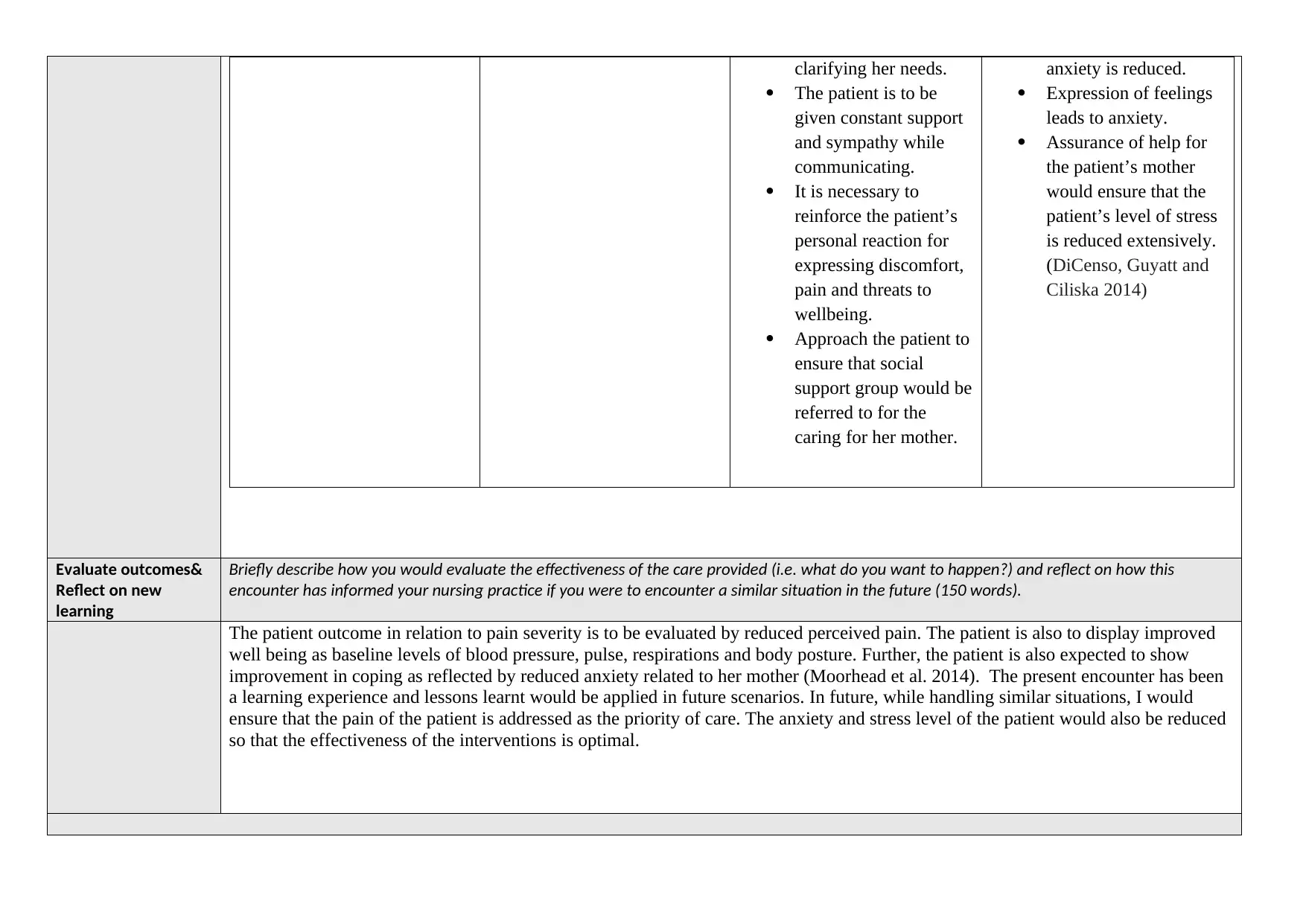
clarifying her needs.
The patient is to be
given constant support
and sympathy while
communicating.
It is necessary to
reinforce the patient’s
personal reaction for
expressing discomfort,
pain and threats to
wellbeing.
Approach the patient to
ensure that social
support group would be
referred to for the
caring for her mother.
anxiety is reduced.
Expression of feelings
leads to anxiety.
Assurance of help for
the patient’s mother
would ensure that the
patient’s level of stress
is reduced extensively.
(DiCenso, Guyatt and
Ciliska 2014)
Evaluate outcomes&
Reflect on new
learning
Briefly describe how you would evaluate the effectiveness of the care provided (i.e. what do you want to happen?) and reflect on how this
encounter has informed your nursing practice if you were to encounter a similar situation in the future (150 words).
The patient outcome in relation to pain severity is to be evaluated by reduced perceived pain. The patient is also to display improved
well being as baseline levels of blood pressure, pulse, respirations and body posture. Further, the patient is also expected to show
improvement in coping as reflected by reduced anxiety related to her mother (Moorhead et al. 2014). The present encounter has been
a learning experience and lessons learnt would be applied in future scenarios. In future, while handling similar situations, I would
ensure that the pain of the patient is addressed as the priority of care. The anxiety and stress level of the patient would also be reduced
so that the effectiveness of the interventions is optimal.
The patient is to be
given constant support
and sympathy while
communicating.
It is necessary to
reinforce the patient’s
personal reaction for
expressing discomfort,
pain and threats to
wellbeing.
Approach the patient to
ensure that social
support group would be
referred to for the
caring for her mother.
anxiety is reduced.
Expression of feelings
leads to anxiety.
Assurance of help for
the patient’s mother
would ensure that the
patient’s level of stress
is reduced extensively.
(DiCenso, Guyatt and
Ciliska 2014)
Evaluate outcomes&
Reflect on new
learning
Briefly describe how you would evaluate the effectiveness of the care provided (i.e. what do you want to happen?) and reflect on how this
encounter has informed your nursing practice if you were to encounter a similar situation in the future (150 words).
The patient outcome in relation to pain severity is to be evaluated by reduced perceived pain. The patient is also to display improved
well being as baseline levels of blood pressure, pulse, respirations and body posture. Further, the patient is also expected to show
improvement in coping as reflected by reduced anxiety related to her mother (Moorhead et al. 2014). The present encounter has been
a learning experience and lessons learnt would be applied in future scenarios. In future, while handling similar situations, I would
ensure that the pain of the patient is addressed as the priority of care. The anxiety and stress level of the patient would also be reduced
so that the effectiveness of the interventions is optimal.
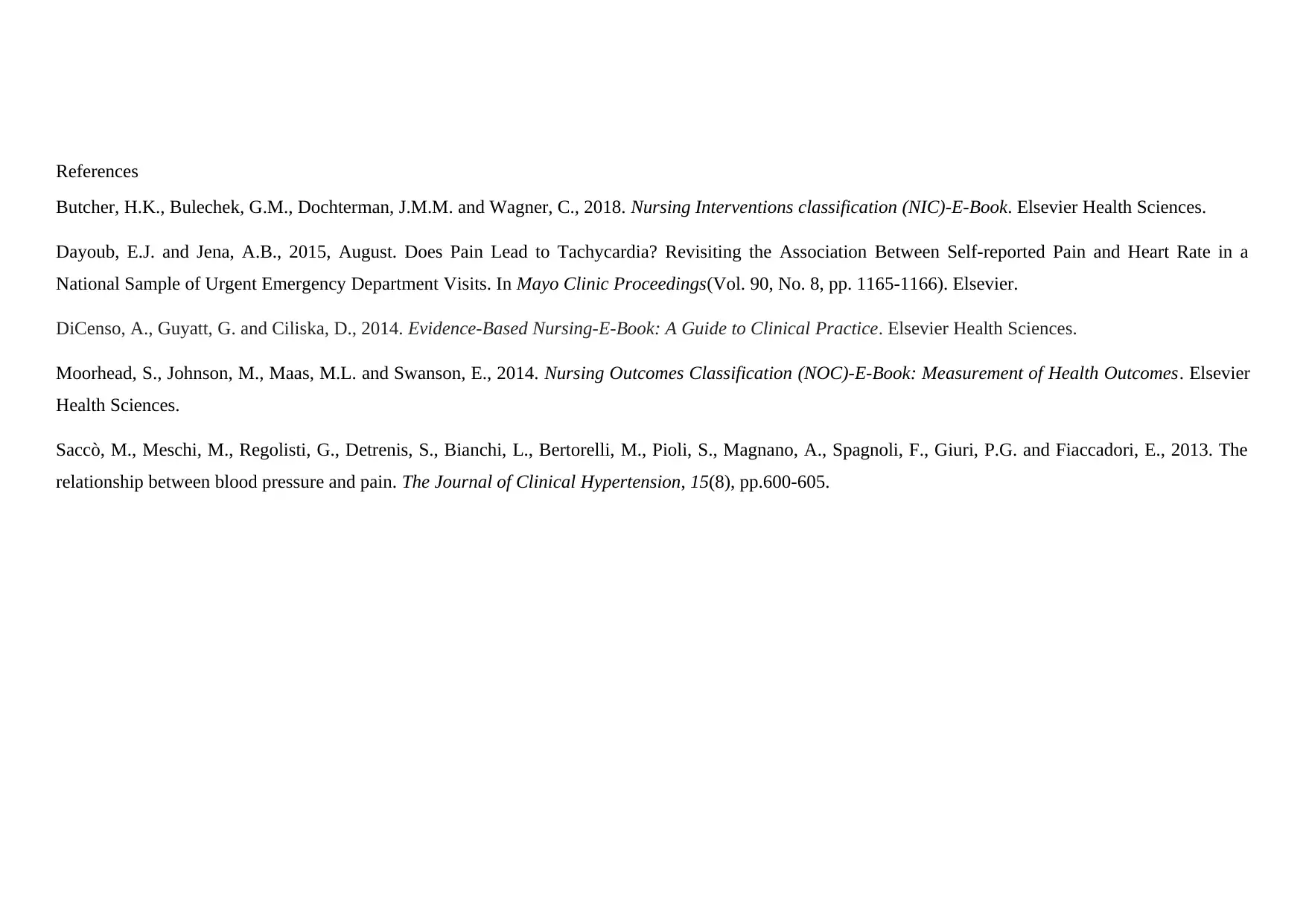
References
Butcher, H.K., Bulechek, G.M., Dochterman, J.M.M. and Wagner, C., 2018. Nursing Interventions classification (NIC)-E-Book. Elsevier Health Sciences.
Dayoub, E.J. and Jena, A.B., 2015, August. Does Pain Lead to Tachycardia? Revisiting the Association Between Self-reported Pain and Heart Rate in a
National Sample of Urgent Emergency Department Visits. In Mayo Clinic Proceedings(Vol. 90, No. 8, pp. 1165-1166). Elsevier.
DiCenso, A., Guyatt, G. and Ciliska, D., 2014. Evidence-Based Nursing-E-Book: A Guide to Clinical Practice. Elsevier Health Sciences.
Moorhead, S., Johnson, M., Maas, M.L. and Swanson, E., 2014. Nursing Outcomes Classification (NOC)-E-Book: Measurement of Health Outcomes. Elsevier
Health Sciences.
Saccò, M., Meschi, M., Regolisti, G., Detrenis, S., Bianchi, L., Bertorelli, M., Pioli, S., Magnano, A., Spagnoli, F., Giuri, P.G. and Fiaccadori, E., 2013. The
relationship between blood pressure and pain. The Journal of Clinical Hypertension, 15(8), pp.600-605.
Butcher, H.K., Bulechek, G.M., Dochterman, J.M.M. and Wagner, C., 2018. Nursing Interventions classification (NIC)-E-Book. Elsevier Health Sciences.
Dayoub, E.J. and Jena, A.B., 2015, August. Does Pain Lead to Tachycardia? Revisiting the Association Between Self-reported Pain and Heart Rate in a
National Sample of Urgent Emergency Department Visits. In Mayo Clinic Proceedings(Vol. 90, No. 8, pp. 1165-1166). Elsevier.
DiCenso, A., Guyatt, G. and Ciliska, D., 2014. Evidence-Based Nursing-E-Book: A Guide to Clinical Practice. Elsevier Health Sciences.
Moorhead, S., Johnson, M., Maas, M.L. and Swanson, E., 2014. Nursing Outcomes Classification (NOC)-E-Book: Measurement of Health Outcomes. Elsevier
Health Sciences.
Saccò, M., Meschi, M., Regolisti, G., Detrenis, S., Bianchi, L., Bertorelli, M., Pioli, S., Magnano, A., Spagnoli, F., Giuri, P.G. and Fiaccadori, E., 2013. The
relationship between blood pressure and pain. The Journal of Clinical Hypertension, 15(8), pp.600-605.
1 out of 6
Related Documents
Your All-in-One AI-Powered Toolkit for Academic Success.
+13062052269
info@desklib.com
Available 24*7 on WhatsApp / Email
![[object Object]](/_next/static/media/star-bottom.7253800d.svg)
Unlock your academic potential
© 2024 | Zucol Services PVT LTD | All rights reserved.





